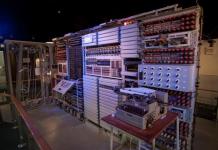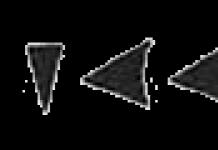Subject: Number systems. Positional and non-positional number systems.
Target: introduce the history of the emergence and development of number systems, point out the main disadvantages and advantages of non-positional number systems.
Lesson teaching software: PC, handouts, posters.
During the classes
I.Organizing time.
II. Setting lesson goals.
1. “Everything is a number.” What did the ancient Pythagoreans mean?
2. How many development systems are there? Which was the first and why?
3. Roman number CXXVII. What quantity does it express?
4. Number systems based on the positional principle arose independently of one another in ancient Mesopotamia (Babylon), among the Maya tribe and, finally, in India. All this suggests that the emergence of the positional principle was not an accident. What were the prerequisites for its creation? What led people to this remarkable discovery?
5. Is 3FA4 a number?
6. Who and when counted in fives and dozens?
III. Presentation of new material.
1. Number systems.
Slogan "Everything is a number"
This is what the Pythagoreans said, emphasizing the extremely important role of numbers in practical activity. A modern person remembers car and telephone numbers every day, calculates the cost of purchases in a store, maintains a family budget, etc., etc. Numbers, numbers... they are with us everywhere.
People have always counted and written down numbers, even five thousand years ago. But they wrote them down completely differently, according to different rules. But in any case, the number was depicted using any or several symbols called numbers.
Numbers- these are the symbols involved in writing a number and making up some alphabet.
What is a number then?
Initially, the number was tied to those items that were counted. But with the advent of writing, number was separated from objects of counting and the concept of a natural number appeared. Fractional numbers appeared due to the fact that a person needed to measure something and the unit of measurement (standard) did not always fit an integer number of times into the measured value. Further, the concept of number developed in mathematics and today is considered a fundamental concept not only of mathematics, but also of computer science.
Number- this is a certain quantity.
Numbers are made up of digits according to special rules. At different stages of human development, among different peoples, these rules were different, and today we call them number systems.
Notation is a way of writing numbers using digits.
All known number systems are divided into positional and non-positional. Non-positional number systems arose earlier than positional ones. The latter are, in turn, the result of a long historical development of non-positional number systems.
2. Non-positional number systems.
Non-positional is a number system in which the quantitative equivalent (“weight”) of a digit does not depend on its location in the number record.
1) Unit number system.
In ancient times, when people began to count, there was a need to write down numbers. The number of objects, for example, bags, was depicted by drawing dashes or serifs on any hard surface: stone, clay, wood (the invention of paper was still very far away). Each bag in such a record corresponded to one line. Archaeologists have found such “records” during excavations of cultural layers dating back to the Paleolithic period (10-11 thousand years BC).
Scientists called this method of writing numbers the unit or unary number system. The inconveniences of such a number system are obvious: the larger the number you need to write, the more sticks there are. When writing down a large number, it is easy to make a mistake - add an extra number of sticks or, conversely, not add enough sticks.
Therefore, later these badges began to be combined into groups of 3.5 and 10 sticks. Thus, more convenient number systems arose. Echoes of the unit number system are still found today. For example, without realizing it, kids show their age on their fingers, and counting sticks were used to teach 1st grade students how to count.
2) Ancient Egyptian decimal non-positional number system.
The ancient Egyptian decimal non-positional system arose in the second half of the third millennium BC. e. The paper was replaced by a clay tablet, and that is why the numbers have such an outline.
In this number system, key numbers 1, 10, 100, 1000, etc. were used as numbers and they were written using special hieroglyphs.
It was from the combination of such “digits” that numbers were written and each “digit” was repeated no more than nine times.
Why? ( Since ten consecutive identical digits can be replaced by one number, but one digit higher.) All other numbers were compiled from these key numbers using ordinary addition. First they wrote the number of the highest order, and then the lower one.
The number 2346 was “drawn” like this:
Two lotus flowers (two thousand);
Three rolled palm leaves (three hundred);
Four arcs (four tens);
Two poles (two units).
The Egyptians performed multiplication and division by sequential doubling of numbers - a special role was assigned to two.
The Egyptians calculated 19×31 this way: they successively doubled the number 31. The results of doubling were recorded in the right column, and the corresponding power of two was written in the left column.
https://pandia.ru/text/78/014/images/image002_94.gif" width="14 height=14" height="14">The Slavs, like the Greeks, knew how to write numbers greater than 1000. To do this, New designations were added to the alphabetic system. So, for example, the numbers 1000, 2000, 3000... were written in the same “digits” as 1,2, 3..., only a special sign was placed in front of the “digit” at the bottom left.
The number 10000 was denoted by the same letter as 1, only without a title, it was circled. This number was called “darkness”. This is where the expression “darkness to the people” comes from.
Thus, to indicate “themes” (plural of the word darkness), the first 9 “digits” were circled.
10 topics, or, was a unit of the highest category. They called it "legion". 10 legions made up the leord. The largest of the quantities that have their own designation was called “deck”; it was equal to 1050. It was believed that “the human mind cannot comprehend more than this.”
This method of writing numbers, as in the alphabetic system, can be considered as the beginnings of a positional system, since in it the same symbols were used to designate units of different digits, to which only special signs were added to determine the value of the digit.
Alphabetic number systems were of little use for operating With large numbers. During the development of human society, these systems gave way to positional systems.
3. Transition from non-positional number systems to positional ones.
What are the disadvantages of non-positional number systems? (Writing large numbers involves a large number of digits. It is inconvenient to perform arithmetic operations. It is impossible to represent negative and fractional numbers.)
Due to the above-mentioned disadvantages, non-positional number systems gradually gave way to positional number systems.
Indian multiplicative system
Number systems based on the positional principle arose independently of one another in ancient Mesopotamia (Babylon), among the Maya tribe and, finally, in India. All this suggests that the emergence of the positional principle was not an accident.
What were the prerequisites for its creation? What led people to this remarkable discovery?
To answer these questions, we again turn to the story of ancient China, India, and some other countries that had recording systems based on the multiplicative principle.
Let, for example, tens be denoted by the symbol X, and hundreds by Y. Then the recording of the number 323 will schematically look like this: 3Y 2X 3. In such systems, the same symbols are used to write the same number of units, tens, hundreds or thousands, but after For each symbol, the name of the corresponding category is written. Using the introduced notation, the number 100 can be written as 1Y.
The next step to the positional principle was the omission of the names of categories when writing, just as we say “three twenty” and not “three rubles twenty kopecks.” But when writing numbers using such a system, a symbol was often required to indicate the missing digit.
The modern decimal number system arose around the 5th century AD. e. in India. The emergence of this system became possible after the greatest discovery - the number “0” to indicate a missing value.
How did zero appear?
Anyone who has become familiar with the Babylonian number system remembers that the Babylonians already used a special symbol to designate the zero digit. Around the 2nd century BC. e. Greek scientists became acquainted with the astronomical observations of the Babylonians. Along with their calculation tables, they also adopted the Babylonian number system, but they wrote numbers from 1 to 59 not with wedges, but in their own alphabetical numbering. But the most remarkable thing was that to designate the zero digit, Greek astronomers began to use the symbol “O” (the first letter of the Greek word Ouden - nothing). This sign, apparently, was the prototype of our zero.
Indians became acquainted with Greek astronomy between the 2nd and 6th centuries. n. e., this is evident from the fact that they adopted the general theoretical principles of this science and many Greek terms. At this time, India used a multiplicative number system. According to historians, around this time the Indians became acquainted with both the Babylonian number system and the Greek zero. The Indians combined their decimal multiplicative system with the numbering principles of Greek astronomers. This was the final step in creating our decimal number system.
The modern decimal number system, which is positional, uses 10 Arabic numerals. Why do we call our numbers Arabic? The Arabs were the first to become familiar with the decimal number system that arose in India. They appreciated it and began to use it for settlements in trade transactions. It was the Arabs who brought this number system to Europe. From the beginning of the 12th century, this decimal number system became widespread throughout Europe under the name Arabic. Being simpler and more convenient than other systems, it quickly replaced all other ways of writing numbers. Since then, the numerals used to write numbers in the decimal system are called Arabic.
4. Positional number systems.
Positional is a number system in which the quantitative equivalent (“weight”) of a digit depends on its location in the number record.
Example.
Consider the number 222.
In writing this number, the digit 2 is used three times. But the contribution of each digit to the value of the number is different. The first 2 means the number of hundreds, the second - the number of tens, the third - the number of units. If we compare the “weight” of each digit in this number, it turns out that the first 2 is “more” than the second by 10 times and “more” by the third by 100 times. This principle is absent in non-positional number systems.
The main advantages of any positional number system:
1. ease of performing arithmetic operations;
2. limited number of characters required to write a number.
The positional system of writing numbers is convenient and economical not only for writing numbers with signs on paper and for performing arithmetic operations on them. It is also convenient for mechanical representation of numbers. Let's remember, for example, abacus. Each digit of a number (units, tens, hundreds, thousands, etc.) on the abacus corresponds to its own wire. The tiles on this wire can occupy ten different positions (the eleventh position - when all ten tiles are on the left side - is allowed only in the middle of the calculations, and at the end it is forbidden: all ten tiles must be thrown to the right, and on the next highest wire there is one the bone is thrown from right to left).
Discharge is the position of the digit in the number.
Base (basis) positional number system is the number of digits or other signs used to write numbers in a given number system.
There are a lot of positional systems, since any number not less than 2 can be taken as the base of the number system.
We will write down data on some number systems in a table.
Name | Base | Numbers | Where is it used? |
Binary | |||
Octal | |||
Hexadecimal | 0,1,2,3,4,5,6,7,8,9, A, B, C, D, E, F | ||
Decimal | 0,1,2,3,4,5,6,7,8,9 | In modern everyday life |
|
Fivefold |
Remember how information is encoded in a computer? (Using binary coding, i.e. any information is represented as a sequence of 0s and 1s.)
VI. Consolidation of what has been learned.
Solve problems:
№1. What numbers are written using Roman numerals: MMIV, LXV, CMLXIIV?
№2. Write down the number 555:
A) in the ancient Egyptian number system;
B) in the Roman number system;
B) in the ancient Slavic number system.
№3. Write the numbers from 15 to 25 in the Old Slavonic number system.
V. Lesson summary.
What is a number system?
What are the different number systems?
Homework.
§2.6, questions p.92, write down your date of birth using the non-positional number systems known to you, come up with your own non-positional number system, indicating at the same time: what signs are used as numbers and the rules by which numbers are formed from these numbers. Write down the numbers 352, 2004, 25.
IN non-positional number systems the quantity denoting a digit does not depend on its position in the number. In addition, the system can impose restrictions on the arrangement of numbers, For example so that the numbers are arranged in descending order.
There are the following non-positional number systems:
Unit number system,
Five-fold number system (Heel counting),
Ancient Egyptian number system,
Babylonian number system
Alphabetic number systems,
Jewish number system
Greek number system,
Roman number system,
Mayan number system
Inca quipu,
Let's consider some of the number systems given above.
Unit number system.
From the first attempts to learn to count, people began to need to write down numbers. At first it was easy - a notch or dash on any surface was responsible for one object. Thus the first number system arose - single.
Number in unit number system is a string of dashes (sticks), the number of which is equal to the value of a given number. Thus, a harvest of 100 dates will be equal to a number consisting of 100 dashes.
At a later time, to simplify the perception of large numbers, these signs began to be grouped in groups of three or five. Then, equal volume groups of signs began to be replaced with a new sign - this is how the prototypes of modern numbers arose.
This system has significant drawbacks - the larger the number, the longer the string of sticks. In addition, there is a high probability of writing a number by missing or accidentally adding a stick.
Initially, fingers were used in counting, so the first signs appeared for groups of 5 and 10 pieces (units). All this made it possible to create more convenient systems for recording numbers.
Ancient Egyptian decimal number system.
Ancient Egypt used its own symbols (numbers) to represent numbers 1, 10, 102, 103, 104, 105, 106, 107 . Here are some of them:
Why do we call it decimal? As stated above - people began to group symbols. In Egypt, they decided to group by 10, leaving the number “1” unchanged. Here, the number 10 is called decimal base, and all symbols are a representation of the number 10 to a certain degree.
Numbers in ancient Egyptian number system were written down in the form of combinations of such symbols, and all of them were repeated no more than 9 times. The result was the sum of the elements of the number. This method of obtaining a value is characteristic of every non-positional number system. For example, look at the entry for the number 345:
Babylonian sexagesimal number system.
IN Babylonian number system only 2 symbols were used: a “straight” wedge for units and a “lying” wedge for tens. To determine the value of a number, you need to divide the image of the number into digits from right to left. A new discharge begins with the appearance of a straight wedge after a recumbent one. For example, let's look at the number 32:
The number 60 and all its powers are also denoted by a straight wedge, like “1”. Therefore, the Babylonian number system was called sexagesimal number system.
The Babylonians wrote all numbers from 1 to 59 in the non-positional decimal system, and values greater than 59 in the positional system. basis 60. For example, the number 92:

The recording of the number was not specific, since there was no digit that would indicate zero. Number representation 92 could mean not only 92=60+32 , but also, for example, 3632=3600+32 . To determine the absolute value of a number, they introduced a new symbol to indicate the missing sexagesimal place, which corresponds to the appearance of the number 0 in the decimal notation:
So, the number 3632 is written like this:

Babylonian sexagesimal system- the first number system that is partly based on the positional principle. This number system is still used today. For example, to determine time, an hour consists of 60 minutes, and a minute consists of 60 seconds.
Roman number system.
Roman number system a little similar to the Egyptian one. Here to denote numbers 1, 5, 10, 50, 100, 500 And 1000 use capital Latin letters I, V, X, L, C, D And M respectively. Number in roman number system is a set of consecutive numbers.
Ways to determine the value of a number:
- The value of a number corresponds to the sum of the values of its digits. For example, number 32 in the Roman numeral system it is written like this XXXII=(X+X+X)+(I+I)=30+2=32
- When there is a smaller one to the left of a larger digit, the value is the difference between the larger and smaller digits. In addition, the left digit can be less than the right one by a maximum of 1 order of magnitude: i.e. before L(50) And C(100) of the “younger” there can only be X(10), before D(500) And M(1000)- only C(100), before V(5)- only I(1); The number 444 in the Roman numeral system looks like this:
CDXLIV = (D-C)+(L-X)+(V-I) = 400+40+4=444.
- The value is equal to the sum of the values of groups and numbers that do not fit into points 1 and 2.
Wikispaces was founded in 2005 and has since been used by educators, companies and individuals across the globe.
Unfortunately, the time has come where we have had to make the difficult business decision to end the Wikispaces service.
We first announced the site closure in January 2018, through a site-wide banner that appeared to all logged-in users and needed to be clicked on to dismiss
During the closure period a range of banners were shown to users, including a countdown banner in the final month. Additionally, the home page of Wikispaces.com became a blog, detailing the reasons for the closure. Private Label Site Administrators were contacted separately regarding the closure
| Wikispaces Tier | Closedown Date |
|---|---|
| Classroom and Free Wikis end of service | 31st July 2018 |
| Plus and Super Wikis end of service | 30th September 2018 |
| Private Label Wikis end of service | 31st January 2019 |
Why has Wikispaces closed?
Approximately 18 months ago, we completed a technical review of the infrastructure and software we used to serve Wikispaces users. As part of the review, it became apparent that the required investment to bring the infrastructure and code in line with modern standards was very substantial. We explored all possible options for keeping Wikispaces running but had to conclude that it was no longer viable to continue to run the service in the long term. So, sadly, we had to close the site - but we have been touched by the messages from users all over the world who began creating wikis with it and now running them on new platforms.
We would like to take this opportunity to thank you for your support over the years.
Number system is a set of techniques and rules for representing numbers using digital signs.
Non-positional is a number system in which the value of any digit does not depend on the position (position) in the series of digits representing this number.
For example, in the number XXX, written in the Roman numeral system, each digit means 10 units.
Task 1. Write the numbers in Roman numeration: a) 193; b) 564; c) 2708.
Solution: a) 193 - is one hundred (C) + ninety, i.e. one hundred without ten (XC) + three (III). Therefore, 193 will be written as CXCIII.
b) 564 is five hundred (D) + fifty (L) + ten (X) + four (IV), i.e. the number 564 will be written as DLХIV.
c) 2708 is two thousand (MM) + plus five hundred (D) + one hundred (C) + one hundred (C) + five (V) + three (III). Therefore, the number 2708 is written as follows: MMDCCVIII.
Positional is a number system in which the value of any digit depends on its position (position) in a series of digits representing this number.
For example, the number 3 in the number 723, written in the decimal number system, means three units, and in the number 325 - three hundreds. Positional SS include the sexagesimal Babylonian and decimal number systems.
Under number system base refers to a certain constant ratio of units of adjacent digits for a given number system.
The base of the number system can be any natural number greater than 1.
A number system with a base equal to 1 is called unary.
To record numbers in the positional number system, digits are used, the number of which corresponds to the base of the system.
Decimal number system, writing numbers in it
In practice, the decimal number system was established. As you know, in decimal SS, 10 characters (digits) are used to write numbers: 1,2,3,4,5,6,7,8,9,0. From them finite sequences are formed, which are short records of numbers. For example, the sequence 3745 is a short form for the number.
Definition 4. Decimal notation of a natural number x its representation is called:
where the coefficients a n, a n-1, ..., a 1, a 0 take values 0, 1, 2, 3, 4, 5, 6, 7, 8, 9 and
It is customary to write a sum in short form as a sequence of numbers with a bar at the top to distinguish it from a product of numbers:
Since the concept of a number and its notation are not identical, the existence and uniqueness of the decimal notation of the natural notation must be proven.
Theorem 1. Any natural number X can be represented as:
where the coefficients a n , a n-1 , …, a 1 , a 0 take values 0, 1, 2, 3, 4, 5, 6, 7, 8, 9
and such a record is the only one.
Decimal notation of a number makes it easy to decide which one is smaller.
Theorem 2. Let X And at – natural numbers, written in the decimal number system:
Then the number X less number at , if one of the conditions is met:
A) n
b) n = m, but a n ;
V) n = m, a n = b n, …, a k = b k, But a k-1 .
Example: 1) if X= 345
, A at= 4678
, That X
2) if X= 345, a at= 467, then x
3) If X= 3456, a at= 3467, then x
Rank
If a natural number X presented in the form , then the numbers 1, 10, 10 2 , …, 10 n called digit units respectively first, second, ..., n+1 rank, with 10 units of one rank making up one unit of the next highest rank, i.e. the ratio of adjacent digits is equal to 10 – the base of the number system.
The first three digits in the notation of a number connect one group and are called first class, or class of units. The first class includes ones, tens and hundreds.
The fourth, fifth and sixth digits in the number form form second class – thousand class. Then follows third class – million class, also consisting of three categories: seventh, eighth and ninth, i.e. from units of millions, tens of millions and hundreds of millions.
The next three digits also form a new class, etc. identifying classes of units, thousands, millions, etc. creates convenience for writing and reading numbers.
In decimal SS, all numbers can be given a name (name). this is achieved in the following way: there are the names of the first 10 numbers, then from them, in accordance with the definition of decimal notation and by adding a few more words, the names of subsequent numbers are formed. So the numbers of the second ten, represented in the form, are formed from the combination of the first ten names and a slightly modified word ten (“twenty”):
eleven- one in ten;
twelve- two by ten, etc.
Maybe it would be more natural to say “two and ten,” but our ancestors preferred to say “two by ten,” which is what was preserved in speech.
The word "twenty" means two tens. Continuing the count, we get the name of the numbers third, fourth, fifth, sixth, etc. dozens. Only in three cases do new words appear: forty, ninety and hundred. Ten tens are called a hundred. The names of the numbers of the second hundred are made up of the word “hundred” and the names of the numbers of the first and subsequent tens. Having counted a new hundred, we will have two hundred, which for brevity are called “two hundred”. Then we will get special names: three hundred, four hundred, five hundred, etc. until we count 10 hundreds, which are called thousand . After counting thousands of thousands, we get a number called million (10 6). Next we count in millions until we reach a thousand millions, this number is called - billion (10 9). It's called a million million billion (10 12). Then we get a trillion (10 15), then a quadrillion (10 18), etc.
Thus, to name all the natural numbers within a billion, only 16 different words were required: one, two, three, four, five, six, seven, eight, nine, ten, forty, ninety, one hundred, thousand, million, billion. The remaining names of numbers (within a billion) are formed from the basic ones.

















